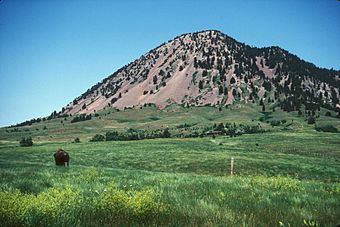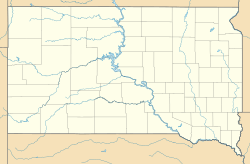Bear Butte facts for kids
|
Bear Butte
|
|
 |
|
| Location | Meade County, South Dakota |
|---|---|
| Nearest city | Sturgis, South Dakota |
| NRHP reference No. | 73001746 |
Quick facts for kids Significant dates |
|
| Added to NRHP | June 19, 1973 |
| Designated NHL | December 21, 1981 |
Bear Butte is a special mountain in South Dakota, United States. It's located near the town of Sturgis, South Dakota. This unique place became a State Park in 1961.
Long before Europeans arrived, Bear Butte was a very important landmark and religious site for Plains Indians tribes. The Lakota (also known as Sioux) call it Matȟó Pahá, which means Bear Mountain. The Cheyenne people know it as Noahȧ-vose ("giving hill") or Náhkȯhe-vose ("bear hill"). For the Cheyenne, it's where their prophet, Sweet Medicine, received important knowledge from Ma'heo'o (God). This knowledge helped shape their way of life.
Many Native American peoples consider this mountain sacred. They often visit for spiritual journeys. During these visits, they leave prayer cloths and tobacco bundles tied to tree branches. Other offerings are sometimes left at the very top of the mountain. Bear Butte is a place for prayer, quiet thought, and peace.
The park offers different activities for visitors. There's a campsite where you can go horseback riding, fishing, and boating. On the other side of Highway 79, a group of buffalo roams near the mountain's base. You can also find an education center and a trail to the mountain's summit. Park rules ask all visitors to be respectful of people who are there for religious reasons. They also ask that you do not disturb any religious offerings. If you are visiting for religious activities, you do not have to pay park fees.
How Bear Butte Was Formed
Bear Butte is not a typical "butte." A butte is usually formed when wind and water wear away soft rock, leaving harder rock behind. Bear Butte is actually a laccolith. This means it was formed when hot, melted rock, called magma, pushed its way up from deep inside the Earth. This magma pushed up the layers of rock above it, creating a dome shape. Over a very long time, the softer rock layers on top wore away, leaving the harder, dome-shaped rock we see today.
This process happened during the Eocene Epoch, a very long time ago. Bear Butte shares a similar story with other famous places in the region. These include the Black Hills, Devils Tower, and the Missouri Buttes. It's possible that some magma even broke through the surface, forming a volcano. But if it did, that volcano would have worn away long ago.
The peak of Bear Butte rises about 1,253 feet (382 meters) above the flat land around it. It stands 4,426 feet (1,349 meters) above sea level.
A Long History at Bear Butte
People have been interested in Bear Butte for a very long time. Scientists have found tools and other items near the mountain that are up to 10,000 years old. This shows that people have visited this special place for thousands of years. The Cheyenne and Lakota people have always felt a deep spiritual connection to Bear Butte.
Many famous Native American leaders visited Bear Butte. These include Red Cloud, Crazy Horse, and Sitting Bull. They often came here for spiritual journeys and important discussions. In 1857, many different Native American nations met at Bear Butte. They gathered to talk about the increasing number of white settlers moving into the Black Hills area.
In 1874, a U.S. Army expedition led by George Armstrong Custer came to the Black Hills. This was against a treaty signed in 1868. Custer's group camped near Bear Butte. They confirmed that there was gold in the Black Hills. After this, many gold seekers and settlers rushed into the area. Bear Butte became an easy landmark for them to find. Native Americans were very upset by these illegal movements onto their lands. Eventually, the U.S. government broke its treaty promises. It then tried to move all northern Plains tribes onto reservations.
Later, a family named Bovee owned the land on the southern side of the mountain. In 1945, during World War II, the Northern Cheyenne asked the Bovee family for permission to hold a ceremony at Bear Butte. They wanted to pray for the war to end. The Bovee family was very welcoming and encouraged Native American religious ceremonies over the years.
By the mid-1950s, Ezra Bovee wanted Bear Butte to become a national park. After he passed away, his family continued this effort. When the national government's interest faded, the state government of South Dakota stepped in. Bear Butte officially became a state park in 1961. It was recognized as a National Historic Landmark in 1981.
Frank Fools Crow, a respected Lakota ceremonial chief, visited Bear Butte throughout his life. He taught that all people should live in peace and harmony. He strongly believed the Lakota should never sell the Black Hills. Today, a statue and plaque honor Frank Fools Crow near the education center at Bear Butte State Park.
In 2011, the National Trust for Historic Preservation listed Bear Butte as one of "America's 11 Most Endangered Places." This was to highlight its importance and the need to protect it. Native American tribes have also bought land around the butte to help preserve its cultural meaning.
Images for kids





